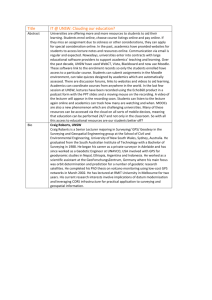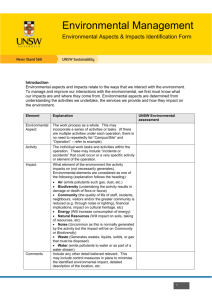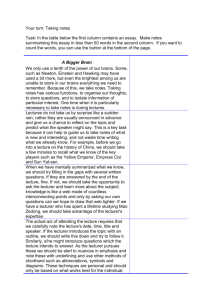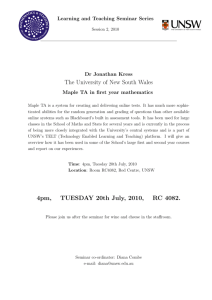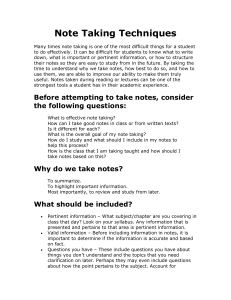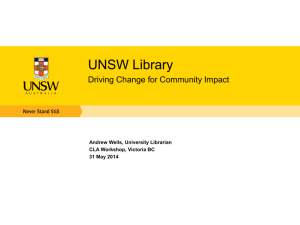advertisement
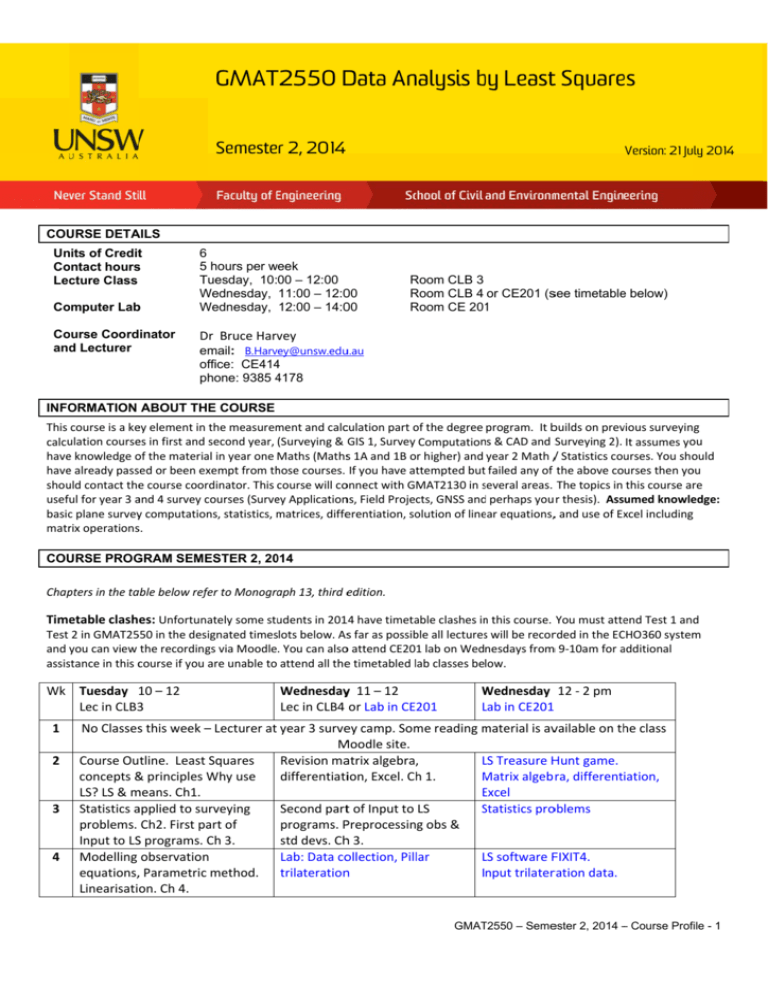
GMAT T2550 D Data An nalysis by b Leastt Squarees Semester 2, 2014 Version: 21 July 2014 COU URSE DETA AILS Co omputer Lab b 6 5 hours per week w Tuesday, 10:00 – 12:00 11:00 – 12:0 W Wednesday, 00 W Wednesday, 12:00 – 14:0 00 Co ourse Coordinator and d Lecturer Dr Bruce Harvvey em mail: B.Harvvey@unsw.eduu.au Un nits of Creditt Co ontact hours s Lec cture Class Room R CLB 3 Room R CLB 4 or CE201 (ssee timetable e below) Room R CE 201 1 offfice: CE414 4 ph hone: 9385 4178 4 INFO ORMATION ABOUT THE COURSE This course is a keey element in the measurem ment and calcculation part o of the degree program. It bbuilds on prevvious surveying ulation coursees in first and second year, (Surveying & GIS 1, Survey Computation ns & CAD and SSurveying 2). It assumes yo ou calcu have e knowledge o of the materiaal in year one Maths (Mathss 1A and 1B or higher) and year 2 Math // Statistics courses. You sho ould have e already passsed or been exxempt from th hose courses. If you have atttempted but failed any of the above courses then yo ou shou uld contact thee course coorrdinator. This course will coonnect with GMAT2130 in sseveral areas. The topics in this course arre useful for year 3 aand 4 survey ccourses (Surve ey Applicationns, Field Projects, GNSS and d perhaps you r thesis). Assumed knowle edge: ns, statistics, m matrices, diffeerentiation, so olution of line ear equations,, and use of Exxcel including basicc plane surveyy computation matrrix operationss. COU URSE PROG GRAM SEME ESTER 2, 20 014 pters in the ta able below refe fer to Monogra aph 13, third eedition. Chap Time etable clashes: Unfortunaately some stu udents in 20114 have timetaable clashes in n this course. You must atte end Test 1 and Test 2 in GMAT25550 in the desiignated timesslots below. Ass far as possib ble all lecturess will be recorrded in the EC CHO360 system m m 9‐10am for a additional and you can view the recordinggs via Moodle. You can alsoo attend CE201 lab on Wednesdays from assisstance in this ccourse if you are unable to attend all thee timetabled lab classes below. Wk Tuesday 10 – 12 Lec in CLB33 1 2 3 4 Wednesdayy 11 – 12 Lec in CLB4 or Lab in CE201 Wednesday W 12 ‐ 2 pm Lab in CE201 L No Classess this week –– Lecturer at year 3 surveey camp. Som me reading m material is avvailable on th he class M Moodle site. Course Outline. Least Squares Revision maatrix algebra,, LS Treasure H L Hunt game. & principles W Why use differentiatiion, Excel. Ch h 1. Matrix algebr M concepts & ra, differentiation, LS? LS & m means. Ch1. Excel E Statistics aapplied to surveying Second partt of Input to LS Statistics pro S oblems problems. Ch2. First paart of programs. PPreprocessing obs & Input to LSS programs. C Ch 3. std devs. Chh 3. Modelling observation n Lab: Data coollection, Pilllar LS software F L FIXIT4. equations,, Parametric method. trilaterationn Input trilaterration data. Linearisation. Ch 4. GMAT T2550 – Semeester 2, 2014 – Course Proffile - 1 Wk Tuesday 10 – 12 Lec in CLB3 Wednesday 11 – 12 Lec in CLB4 or Lab in CE201 Wednesday 12 ‐ 2 pm Lab in CE201 5 Derivation of LS equations. Ch 4. Forming and solving normal Lab: Modelling & linearization equations. Ch 4. Modelling & linearization 6 Least Squares step by step worked examples Ch4. Lab: Revision Test 1 in CE 201 7 VCV matrices, residuals & VF. Ch 4. Review of Test LS aspects of EDM calibration Forming & solving normal equations in Excel. 8 Analysis of Output. Ch 5. Analysis of Output 9 Outliers. Redundancy. Ch 6. Lab: EDM baseline calculations and analysis Survey Design. Ch 7. Lab: Revision Test 2 in CE 201 More examples of network analysis Advanced LS. Ch9. Combined & condition methods No lecture. Final Lab session Recess week 10 Case Studies: Opera House, Harbour Bridge, Chifley Dam control surveys. 11 Combined & condition methods. Ch 8. 12 LS Essentials and Predicting results. Ch 10. Exam discussion. 13 No lecture. Outliers. Simulations Revision HANDBOOK DESCRIPTION See link to virtual handbook - www.handbook.unsw.edu.au/undergraduate/courses/2014/GMAT2550.html OBJECTIVES This course aims to introduce students to the analysis of surveying observations primarily by the least squares method and associated statistical analysis. One part of the course is applied LS, that is, how to use LS programs. The other part of the course is the theoretical aspects of LS and “what’s inside LS programs”. So the course studies both the application of software packages and the detailed calculations within such software. This course provides an environment that fosters in our students the following attributes, those not covered in this course are dealt with in other courses in your program. the skills involved in scholarly enquiry Significant. As you will see understanding Least Squares data analysis can be challenging. It requires a lot more than just learning formula or procedures. an in‐depth engagement with Significant. You will be able to do the calculations that are often hidden inside relevant disciplinary knowledge in its commercial software packages, and you will learn how to professional analyse the interdisciplinary context results. You will apply your knowledge from year 1 mathematics and year 2 statistics courses, to real surveying problems. the capacity for analytical and critical Significant. You are especially encouraged to find more than one solution for some of thinking and for creative problem the problems. solving the ability to engage in independent Optional. There is opportunity for students to learn more about other commercial LS and reflective learning CAD software, to read ahead through the text book, or to write your own computer programs for some of the tasks. the skills to locate, evaluate and use Minor. Study the textbook provided and explore the software options. relevant information (Info. Literacy) the capacity for enterprise, initiative Some – find alternative solution methods to some challenging problems – especially in and creativity the network design topic. the skills required for collaboration Some group work in lab GMAT2550 – Semester 2, 2014 – Course Profile - 2 ASSESSMENT Assessment for the course includes: Mid‐session test 1 20% On Thursday week 6 Mid‐session test 2 20% On Thursday week 10 Computer Labs 16% As described below Assignment (roof pillar network) 9% Details separately Final Exam 35% In formal exam period Overall rationale for and further details about assignments, tests and exams will be given in class. The final exam may cover all aspects of the course, not just those covered after the second midsession test. The computer lab work will be marked in the student’s presence by viewing the students’ notes or computer screens and immediate feedback will be given. There is no need to rewrite the work or to submit formal well written reports. Generally the work will not be collected or be examined in detail unless a student has had difficulties getting correct or good quality output. Generally, lab marks will be assigned using a mastery scheme, i.e. if the work is acceptable it will get full marks if it is not acceptable it will get zero marks, students can resubmit in this case. There will also be a time limit for computer lab work submissions; generally computer lab work is to be shown to the lecturer no more than two weeks after the class commences work on the computer lab. The final grade for this course will normally be based on the sum of the scores from each of the assessment tasks. TEACHING STRATEGIES This course and similar previous courses have been taught by the lecturer for many years, at UNSW and elsewhere. The teaching strategies have been refined over the years based on student feedback and student performance in exams and assignments. Generally lectures are presented on each topic via PowerPoint presentations. These PowerPoint files are available in pdf format for download from the class web site. Some students have said they don’t like ppt in lectures, others do. So I try not to have static slides that are read, instead I ask students questions and use computer demonstrations. I also wrote the textbook (Monograph 13) and provide additional reading material on the class web site for students who prefer to learn by independent reading. An important element of the teaching is the lab classes where students are encouraged to work on assignments and problems in class with direct assistance from the lecturer. The small class sizes currently in this course make it possible to follow these strategies. Another important aspect is that the main software used in this course has been written by the lecturer specifically for students in this course. Suggested Learning Methods You are encouraged to ask questions and participate in class discussions during lectures, computer labs. Read the text and lecture slides. Attempt the computer lab questions and worked examples yourself. Get feedback: Ask the lecturer for help and help each other. After the mid‐session tests visit me individually for feedback. AND after the end of the course you are welcome to see me and get feedback on your final exams and assignments and to collect any of your remaining submissions. I encourage attendance in class and participation because I think it is better for your education than just reading the PowerPoint. You will also notice that I say more in class than what is written on PowerPoint slides. I do not like lectures that read the screen to you. So for example their might be a graphic chart, plan, map or photograph or table of numbers on the screen and we talk about it. If you want to learn by reading then that’s what my textbook (monograph) is for, because the lecture PowerPoint are missing some information. At UNSW, the normal workload expectations of a student are about 150 hours per session for a 6 unit of credit course, including class contact hours, preparation and time spent on all assessable work. Are you a full time student spending less than 40 hours per week on uni studies, including class time? Are you balancing time between courses, i.e. one 6 unit course should get close to the same amount of time as another 6 unit course. GMAT2550 – Semester 2, 2014 – Course Profile - 3 Downloading from Moodle and ECHO360 Apparently downloading files is addictive and there is a similar problem with photocopying. The amount of class and reference material that students can read is now enormous. Most people will download files or photocopy things because if they have the file or the paper, they can read it at any time … so they don’t have to read it now. So hardly anyone reads anymore and people only collect files or printouts or photocopies and store them away. Is getting copies of all the material the only way you can keep up? Have you tried an alternative? It’s an old fashioned process where you place the pages in front of your eyes and you let it go through there into the brain and it is much better than a download or a photocopy. [Paraphrased by Bruce Harvey from an article on Neuroxing (source unknown).] Even better than reading, is to do something to apply the knowledge, e.g. calculate the tutorial problems. In GMAT2550 course, getting the textbook is a good step. But you need to use it too! ECHO360: UNSW now provides a recording of the lectures held in some rooms that are equipped with the ECHO360 system. This is a good thing but be careful how you use it. If you go to lectures with our small classes you can ask questions and hear other students asking questions. You can see the lecturer their face and hands and movements. You can see what they point to or objects they bring to class. You can see what they write on the board. If most of the students attend and participate the lecturer feels good and usually gives a better lecture than if not many students attend or those there seem not interested. Lectures often partly prepare students for lab and tut and field classes later in the same week. If you don’t understand parts of the lecture then watching a replay in ECHO can help. That is, seeing and hearing it for a second time. If you don’t go to lectures because you can watch the ECHO recording instead then you run some risk. If you can watch the ECHO later you might not watch it in time to prepare for the lab class that follows. If you leave it too late to watch the ECHOs then you will have many to watch in the limited time before exams and midsession tests. The ECHO records what is on the screen, not the blackboard, or the laser pointer, or the manual pointer. It records the sound at the front microphone but not always the students who ask questions or the lecturer if he moves around the room without a mic attached. So, please come to class. Feedback from previous year’s students Last year and in previous years our students rated this course very highly in the CATEI surveys (well above the school average and well above the faculty average). All the CATEI questions were highly rated, with no problems standing out. In the anonymous written comments section there were many nice comments. See me if you want to read them. A few years ago we added a second midsession test that reduced the marks that the final exam was worth and also avoided the ‘bottle neck’ that occurs when many of your other courses have tests in week 7 and assignments due in week 12 or 13. The new assessment arrangement is shown below. In 2013 one student suggested “More online quiz as a revision”. If time permits some revision quizzes will be added to the class Moodle site. EXPECTED LEARNING OUTCOMES By the end of this course you should be able to: Learning Outcomes Assessment Methods Understand the basic principles of Least Squares analysis and their application to engineering surveying Setup the equations within a parametric method least squares adjustment Calculate a least squares adjustment of data step by step without using computer programs designed for Least Squares Properly prepare data for Least Squares analysis, including a priori statistics Professionally interpret output from Least Squares analysis software, including variance factor and outlier investigations Design a survey network using least squares analysis, including error ellipses and redundancy number investigations Be familiar with computer programming aspects used within LS software Be able to calibrate and EDM instrument, including measurements and analysis. Test 1, and labs Test 1, and labs Test 1, and labs Lab exercises Final exam, and labs Test 2, Final exam and labs Not assessed Final exam, and labs GMAT2550 – Semester 2, 2014 – Course Profile - 4 RELEVANT RESOURCES Lecture Material (the course website): http://moodle.telt.unsw.edu.au/ (use your zID and Zpass) Text Book Harvey B.R., 2009, Practical Least Squares and Statistics for Surveyors, Monograph 13, Third Edition, School of Surveying & Geospatial Engineering UNSW. Further references are described in the text book. Pocket calculators are required during lecturing hours, for computer labs and practicals in this course. They have to be hand‐ held, internally powered and silent. They must be brought to all classes. Students may use any calculator they wish in this course, however in examinations they may not use pre‐programmed calculators with, for example, traverse close or resection programs. The type of calculator allowed is described by the University at my.unsw.edu.au/student/academiclife/assessment/examinations/Calculator.html Pocket calculators for the final examination in this course are not provided by the University. Some hints about the use of the CASIO fx‐911W for surveying computations will be supplied on the class web site and in exam papers. You will NOT be asked to invert a matrix or multiply large matrices with a calculator in the mid‐session test or the final examination. Computer software relevant to this course and available in the School’s computer lab EE401, includes: FIXIT4 and MS Excel DATES TO NOTE Refer to MyUNSW for Important Dates available at: https://my.unsw.edu.au/student/resources/KeyDates.html PLAGIARISM Beware! An assignment that includes plagiarised material will receive a 0% Fail, and students who plagiarise may fail the course. Students who plagiarise are also liable to disciplinary action, including exclusion from enrolment. Plagiarism is the use of another person’s work or ideas as if they were your own. When it is necessary or desirable to use other people’s material you should adequately acknowledge whose words or ideas they are and where you found them (giving the complete reference details, including page number(s)). The Learning Centre provides further information on what constitutes Plagiarism at: https://student.unsw.edu.au/plagiarism ACADEMIC ADVICE For information about: Notes on assessments and plagiarism, School policy on Supplementary exams, Special Considerations, Solutions to Admin Problems, Year Managers and Grievance Officer of Teaching and Learning Committee, and Refer to Academic Advice on the School website available at: http://www.engineering.unsw.edu.au/civil-engineering/resources/academic-advice GMAT2550 – Semester 2, 2014 – Course Profile - 5
